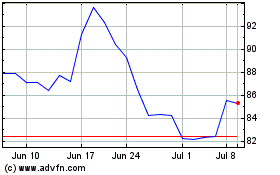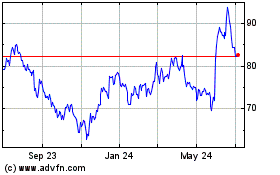By John Simons
Big businesses have embraced flexible work practices, but fewer
of them seem to favor full-time working from home.
International Business Machines Corp., Aetna Inc., Bank of
America Corp., Best Buy Co., Honeywell International Inc. and
Reddit Inc. are among employers that have ended or reduced
remote-work arrangements recently as managers demand more
collaboration, closer contact with customers -- and more control
over the workday.
Bringing workers back to the office isn't easy, managers say.
Remote employees often set their own hours and ways of working, and
bridle when faced with open-plan offices and set meeting
schedules.
A large majority of U.S. employers let staffers telecommute
sometimes, according to the Society for Human Resource
Management.
Yet the portion of U.S. workers who performed all or some of
their work at home fell to 22% last year, from 24% in 2015. Such
workers spent an average of 3.1 hours a day toiling at home last
year, down slightly from 2015, according to the Labor Department's
American Time Use Survey.
Coming back to the office can be "honestly terrifying" for
remote workers, says Andrew Marder, a research analyst with
Capterra Inc., a business-software review site owned by Gartner
Inc.
Mr. Marder telecommuted for about three years while blogging
about investing for the Motley Fool financial website. He was also
a full-time caregiver for his newborn during part of that time, and
juggled writing and parenting duties by working many evenings.
Moving to an office role at Capterra in 2014, Mr. Marder had to
get used to the lack of privacy at work and an hour-plus commute to
Arlington, Va. As a telecommuter, he was used to working at any
hour to meet deadlines. Once in the office, he struggled with
prioritizing tasks and managing his time during work hours,
frequently missing deadlines in the first months on the job.
His manager, J.P. Medved, set weekly meetings to plan Mr.
Marder's workflow, arranging his calendar and plotting everything
from research phone calls to team meetings and deadlines. Mr.
Medved says those changes improved Mr. Marder's ability to submit
work on time.
Bosses acknowledge that remote workers don't suffer from
productivity problems. Research has found telecommuters who can
work outside normal office hours and don't have to spend time
commuting often are more productive than their cubicle-bound
counterparts. Rather, managers want their teams within view and are
willing to trade some efficiency for the serendipity that
office-based conversations might yield.
Companies tend to clamp down on telework during periods of
turmoil and reinvention, says Ken Matos, vice president of research
at Life Meets Work, a workplace consultancy.
"Leaders often say 'I like my co-located team better than my
[remote] team, but the work gets done just as well,'" he adds.
As a finance vice president at Tetra Pak International SA,
George Benaroya observed waves of colleagues return to company
workspaces when new leaders would take over divisions and rein in
remote work.
Office comebacks were often a letdown, recalls Mr. Benaroya, who
left the company in 2012. Workers accustomed to personal space and
sole use of their equipment at home had to adjust to cramped
spaces, full parking lots and jammed printer queues.
The formerly remote employees' egos were bruised, too: The top
managers who made special time for them during office visits paid
less attention once those workers were a regular presence, he says.
Managers spent extra time hand-holding ex-home workers, leaving
less time for other duties.
"You lose efficiency," Mr. Benaroya says.
Tetra Pak spokeswoman Carol Yang says the issues that Mr.
Benaroya describe don't reflect the company's current
situation.
This spring IBM, long a promoter of remote work, offered
thousands of work-from-home employees a choice to follow their
position back to an office location or apply for a new role. Those
who chose to do neither could leave the company.
Marketing manager Dave Wilson spent a decade working from home
in Nashua, N.H. With two young children home during work hours,
distractions abounded and Mr. Wilson says he felt isolated from
colleagues.
So when his job was relocated to Raleigh, N.C., he took a
position marketing the company's Watson artificial intelligence
products at IBM's Littleton, Mass., campus.
Mr. Wilson says he was eager to return to an office, a better
fit for his "water-cooler guy" personality.
He relishes the verbal sparring of the office, too. During a
recent meeting to critique IBM's e-commerce offerings, participants
challenged one another and got in each other's faces to make their
points -- when he attended similar meetings via conference call,
people would disengage unless they were leading the conversation,
he recalls.
IBM's leaders want to provoke those creative tensions, and have
spent $750 million to redevelop its workplaces around a new system
of teamwork; the company has also trained 160,000 employees on
working more nimbly.
As former telecommuters arrive at IBM's Austin, Texas, location,
Joni Saylor will help to integrate them into office culture. Ms.
Saylor, a product design director who worked remotely for IBM until
2013, says telecommuters sometimes struggle to adjust to working in
teams after operating on their own.
Best Buy's work-from-home program gave 5,000 headquarters
employees free rein to choose where they worked, a perk that
complicated tasks like scheduling meetings, says Best Buy spokesman
Jeff Shelman.
"There was no control," he says. "Managers didn't have the tools
to do their jobs."
The company ended the policy in 2013. Workers now arrange time
out of the office with their managers.
The four years since the telework rollback have coincided with
Best Buy's resurgence. Net income has more than doubled in the
period and shares have climbed more than 200%, though the company
is reluctant to draw a connection between those results and the end
of remote work.
"Obviously, there were lots of other things going on," Mr.
Shelman says.
Write to John Simons at John.Simons@wsj.com
(END) Dow Jones Newswires
July 25, 2017 05:44 ET (09:44 GMT)
Copyright (c) 2017 Dow Jones & Company, Inc.
Best Buy (NYSE:BBY)
Historical Stock Chart
From Mar 2024 to Apr 2024

Best Buy (NYSE:BBY)
Historical Stock Chart
From Apr 2023 to Apr 2024
